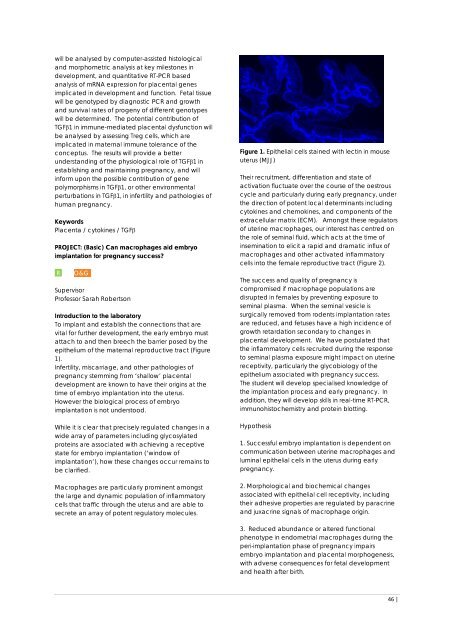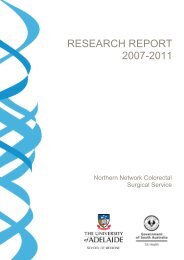Honours Project Book - Faculty of Health Sciences - University of ...
Honours Project Book - Faculty of Health Sciences - University of ...
Honours Project Book - Faculty of Health Sciences - University of ...
You also want an ePaper? Increase the reach of your titles
YUMPU automatically turns print PDFs into web optimized ePapers that Google loves.
will be analysed by computer-assisted histological<br />
and morphometric analysis at key milestones in<br />
development, and quantitative RT-PCR based<br />
analysis <strong>of</strong> mRNA expression for placental genes<br />
implicated in development and function. Fetal tissue<br />
will be genotyped by diagnostic PCR and growth<br />
and survival rates <strong>of</strong> progeny <strong>of</strong> different genotypes<br />
will be determined. The potential contribution <strong>of</strong><br />
TGFβ1 in immune-mediated placental dysfunction will<br />
be analysed by assessing Treg cells, which are<br />
implicated in maternal immune tolerance <strong>of</strong> the<br />
conceptus. The results will provide a better<br />
understanding <strong>of</strong> the physiological role <strong>of</strong> TGFβ1 in<br />
establishing and maintaining pregnancy, and will<br />
inform upon the possible contribution <strong>of</strong> gene<br />
polymorphisms in TGFβ1, or other environmental<br />
perturbations in TGFβ1, in infertility and pathologies <strong>of</strong><br />
human pregnancy.<br />
Keywords<br />
Placenta / cytokines / TGFβ<br />
PROJECT: (Basic) Can macrophages aid embryo<br />
implantation for pregnancy success?<br />
.R. O&G.<br />
Supervisor<br />
Pr<strong>of</strong>essor Sarah Robertson<br />
Introduction to the laboratory<br />
To implant and establish the connections that are<br />
vital for further development, the early embryo must<br />
attach to and then breech the barrier posed by the<br />
epithelium <strong>of</strong> the maternal reproductive tract (Figure<br />
1).<br />
Infertility, miscarriage, and other pathologies <strong>of</strong><br />
pregnancy stemming from ‘shallow’ placental<br />
development are known to have their origins at the<br />
time <strong>of</strong> embryo implantation into the uterus.<br />
However the biological process <strong>of</strong> embryo<br />
implantation is not understood.<br />
While it is clear that precisely regulated changes in a<br />
wide array <strong>of</strong> parameters including glycosylated<br />
proteins are associated with achieving a receptive<br />
state for embryo implantation (‘window <strong>of</strong><br />
implantation’), how these changes occur remains to<br />
be clarified.<br />
Macrophages are particularly prominent amongst<br />
the large and dynamic population <strong>of</strong> inflammatory<br />
cells that traffic through the uterus and are able to<br />
secrete an array <strong>of</strong> potent regulatory molecules.<br />
Figure 1. Epithelial cells stained with lectin in mouse<br />
uterus (MJJ)<br />
Their recruitment, differentiation and state <strong>of</strong><br />
activation fluctuate over the course <strong>of</strong> the oestrous<br />
cycle and particularly during early pregnancy, under<br />
the direction <strong>of</strong> potent local determinants including<br />
cytokines and chemokines, and components <strong>of</strong> the<br />
extracellular matrix (ECM). Amongst these regulators<br />
<strong>of</strong> uterine macrophages, our interest has centred on<br />
the role <strong>of</strong> seminal fluid, which acts at the time <strong>of</strong><br />
insemination to elicit a rapid and dramatic influx <strong>of</strong><br />
macrophages and other activated inflammatory<br />
cells into the female reproductive tract (Figure 2).<br />
The success and quality <strong>of</strong> pregnancy is<br />
compromised if macrophage populations are<br />
disrupted in females by preventing exposure to<br />
seminal plasma. When the seminal vesicle is<br />
surgically removed from rodents implantation rates<br />
are reduced, and fetuses have a high incidence <strong>of</strong><br />
growth retardation secondary to changes in<br />
placental development. We have postulated that<br />
the inflammatory cells recruited during the response<br />
to seminal plasma exposure might impact on uterine<br />
receptivity, particularly the glycobiology <strong>of</strong> the<br />
epithelium associated with pregnancy success.<br />
The student will develop specialised knowledge <strong>of</strong><br />
the implantation process and early pregnancy. In<br />
addition, they will develop skills in real-time RT-PCR,<br />
immunohistochemistry and protein blotting.<br />
Hypothesis<br />
1. Successful embryo implantation is dependent on<br />
communication between uterine macrophages and<br />
luminal epithelial cells in the uterus during early<br />
pregnancy.<br />
2. Morphological and biochemical changes<br />
associated with epithelial cell receptivity, including<br />
their adhesive properties are regulated by paracrine<br />
and juxacrine signals <strong>of</strong> macrophage origin.<br />
3. Reduced abundance or altered functional<br />
phenotype in endometrial macrophages during the<br />
peri-implantation phase <strong>of</strong> pregnancy impairs<br />
embryo implantation and placental morphogenesis,<br />
with adverse consequences for fetal development<br />
and health after birth.<br />
46 |





